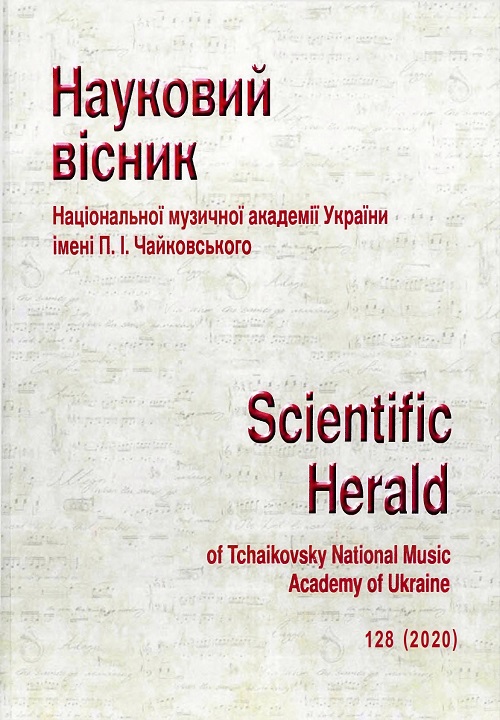Chilean Guitarron as an Instrument of Folk and Religious Usage
DOI:
https://doi.org/10.31318/2522-4190.2020.128.215198Keywords:
guitarron, Chilean guitar art, Chilean cueca, Andean musical cultureAbstract
The relevance of the study is the need to deepen the analytics of Chilean guitar music by studying the influence of Guitarron as an instrument of folk and religious usage on the development of academic guitar art.
Main objectives of the study is to identify the historical and genre aspects of the musical life and development of the Chilean guitarron as well as its influence on modern guitar practice.
The methodology involves the use of historical, systemic, structural-functional methods (for a comprehensive analysis of historical events, studying of genre-stylistic elements of Chilean musical traditions), comparative and phenomenological approaches (for comparing Latin American and European instruments and their organological features). The combination of these methods and approaches provides a wide panorama of the consideration of Chilean Guitarron as a phenomenon and its impact on the processes of developing Chilean musical culture in 20th century and strong relations with national guitar art.
Results and conclusions. The history of the Chilean guitarron as a unique variety of Latin American guitar-like instruments is considered. Its belonging to the sound symbols of the Andean culture is determined. The information on ancient national instruments and musical traditions of Chile of the pre-colonial and colonial periods is systematized. The pedigree of the instrument from the European Renaissance and Baroque guitar is traced. Organological specificity (significantly larger sizes, wide neck, 25 strings in five rows with the addition of diablitos paired trebles) and timbre features were determined. The modern ideas of Chilean researchers about the continuity of the aesthetics of guitar sound associated with the pre-Columbian Andean sound concept, which was formed much earlier than the appearance of European chordophones in Latin America are presented. The discrete character of the guitarron’s development process is outlined, due to the regional isolation of the centers of its occurrence and existence. The specifics of solo and ensemble music playing are determined. The genre-communicative functions of the guitarron as a “Catholic” instrument, involved in Chilean church ceremonies along with the organ, bassoon, harp and vihuela are revealed. The practice of accompanying the sacred, liturgical chants of Canto a lo Divino is considered. The connection with the poetry of the ancient Chilean folk genres Canto a lo Poeta as a source of modern guitar traditions of Chile is determined. The involvement of the guitarron in the creation of the song-dance genre of cueca, as well as socially oriented song culture, is indicated. The process of reviving a forgotten instrument in the twentieth century is associated with restoring the traditions of guitar building, improving the playing technique, forming centers of folk music making and organizing annual guitarronero festivals, concerts and scientific and methodological seminars.
Downloads
References
Ivannikov, T. P. & Filatova, T. V. (2019). Cuatro as a Historical Phenomenon of Venezuelan Guitar Art [Kuatro yak istorychnyi fenomen venesuelskoho hitarnoho mystetstva]. Journal of the Tchaikovsky National Music Academy of Ukraine [Chasopys Natsionalnoi muzychnoi akademii imeni P. I. Chaikovskoho]. Kyiv, 2019. Vol. 4 (45), pp. 7–18 [in Ukrainian].
Guitarrón [online]. Chilean Memory: National Digital Library of Chile [Memoria Chilena : Biblioteca Nacional Digital de Chile]. Avaliable at: http://www.memoriachilena.gob.cl/602/w3- article-93518.html (accessed: 07.04.2020) [in Spanish].
Lenz, R. (1919). On the popular printed poetry of Santiago de Chile. Contribution to Chilean folklore [Sobre la poesía popular impresa de Santiago de Chile. Contribución al folklore chileno]. Annals of the University of Chile [Anales de la Universidad de Chile]. Santiago. № 9 (143). P. 511–622 [in Spanish].
Perez de Arce, J.(2007). The Chilean guitarrón and its timbral harmony [El guitarrón chileno y su armonía tímbrica]. Resonances: Music Research Magazine [Resonancias: Revista de investigación musical]. Vol. 11. № 21. P. 22–55 [in Spanish].
Pinkerton, E. J. (2007). The Chilean Guitarrón: The Social, Political and Gendered Life of a Folk Instrument. Dissertation in partial fulfillment of the requirements for the degree of PhD [online]. Austin : The university of Texas at Austin, 277 p. Available at: https://repositories.lib.utexas.edu/bitstream/handle/2152/13314/pinkertone89242.pdf?sequence=2&i sAllowed=y (accessed: 01.04.2020) [in English].
Rebirth of the Chilean guitarrón [Renacer del guitarrón chileno] (1996). AGENPOCH : National Guild Association of Popular Poets and Payadores of Chile [Asociación Gremial Nacional de Poetas Populares y Payadores de Chile]. Rancagua: FONDART, 100 p. [in Spanish].
Vera, A. (2016). The music between writing and orality: the baroque guitar, the Chilean guitarrón and the song to the divine [La música entre escritura y oralidad: la guitarra barroca, el guitarrón chileno y el canto a lo divino]. Chilean Musical Magazine [Revista Musical Chilena]. Ñuñoa : Instituto de Música Pontificia Universidad Católica de Chile. № 255. P. 9–49 [in Spanish].
Downloads
Published
How to Cite
Issue
Section
License
Our journal abides by the CREATIVE COMMONS copyright rights and permissions for open access journals.
Authors, who are published in this journal, agree to the following conditions:
The authors reserve the right to authorship of the work and pass the first publication right of this work to the journal under the terms of a Creative Commons Attribution License, which allows others to freely distribute the published research with the obligatory reference to the authors of the original work and the first publication of the work in this journal.
The authors have the right to conclude separate supplement agreements that relate to non-exclusive work distribution in the form in which it has been published by the journal (for example, to upload the work to the online storage of the journal or publish it as part of a monograph), provided that the reference to the first publication of the work in this journal is included.




